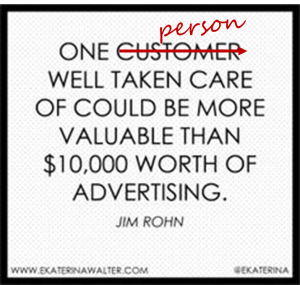Search Waypoint Resources
Your People Are Killing Your Pipeline… Do They Know It?
I work with many different “titles” within Waypoint’s clients, from the executive team to individual contributors at both the front-line and “back office.” The goals typically remain the same:
– Companies want to use feedback processes to measure overall customer sentiment.
– Most also understand the power of using a closed-loop feedback process to drive the right actions with customers by following up on what they are hearing, both with individual accounts (“one-to-one”) and also across accounts in segments (“one-to-many”).
Yet very few translate that process into a customer-centric culture across the company.
This is the lost opportunity, and is doing more harm than most people know.
Every interaction — even when automated — is an opportunity to either create a fan (a “promoter”) or drive an unhappy experience, creating a “detractor.” All interactions matter, even if they aren’t with customers. Consider this real example:
- BAD – Company 1: I recently had an interaction with a client’s Finance organization because they were late in paying their invoice. No names, no phone numbers, no contact info… just an email alias called “accounting” with which I need to interact. When I emailed about the tardy invoice they told me “it is being processed this week, and will go out in the mail following that.” There was no opportunity to address the tardiness or even tell me the ETA.
- GOOD – Company 2: With our first deliverable complete, we submitted our initial invoice, also to an “accounting” email. Within an hour I had a reply from a real human being, confirming receipt of the invoice and the date it will be processed. They also provided a specific date on which the money will be deposited. By the way, they even paid it 1 week early! It really didn’t cost them anything extra and made a great impression.
 I’m may not be a direct customer of these companies but I am often in a position to influence clients and colleagues. That makes it all the more important to pay attention to every interaction and make it as human as possible. I’ll have to think twice before recommending friends or colleagues work with Company 1. I have a much better perception of Company 2 and have experienced friendly, service-oriented throughout. I often suggest that clients check out the products and services Company 2 provides.
I’m may not be a direct customer of these companies but I am often in a position to influence clients and colleagues. That makes it all the more important to pay attention to every interaction and make it as human as possible. I’ll have to think twice before recommending friends or colleagues work with Company 1. I have a much better perception of Company 2 and have experienced friendly, service-oriented throughout. I often suggest that clients check out the products and services Company 2 provides.
When you don’t realize that every customer interaction has the ability to either build or burn a bridge, you may be experiencing high churn rates and not know why. Company 2 uses simple processes to build relationships, while Company 1 hides behind an email shield. As a result, I promote Company 2 at every opportunity.
[bctt tweet=”Every interaction with someone is an opportunity to either create a promoter or a detractor. “]
Although customer-facing employees produce a more immediate impact on company growth, every employee can have an impact on the company’s bottom-line by creating promoters. Don’t forget those other departments when thinking about your Voice-of-Customer / Net Promoter program — are they unknowingly creating detractors (or at least, not taking the opportunity to create a promoter)? It’s a small world… have you created a promoter today?
Here are some easy ways to build relationships even in simple interactions:
- When responding to an email that was sent to a general address (like “accounting”), send it from a real person’s email. Add that human element and show that the issue is important (even if it seems small).
- Make sure employees have their contact information in their email signature. Interactions are a good thing that create relationships – so make it easy for people to reach you!
- Demonstrate empathy – apologize when an issue is unresolved or needs more time and thank the person for their patience/understanding. It may not be “your” fault, but showing some level of recognition for the inconvenience can go a long way.
- If possible, go beyond empathy to address the person’s needs. You may not be able to do what they are asking or solve their problem, but a simple note from Company 1 that said (to the effect of), “I understand you expected this to be paid this week and I’m sorry our Accounts Payable processes wasn’t explained to you. In the future you can contact me directly for any status. And while we do provide expedited payment in some situations your invoice wasn’t included in that process, so I’d like to suggest you speak with [executive sponsor name] to see if we can include your invoices under this program.”
Looking for more best practices? Head over to our whitepapers page.